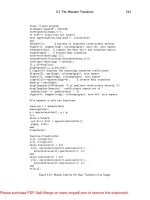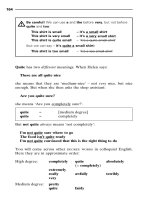Tài liệu A neural-network-based space-vector PWM controller for a three-level voltage-fed inverter induction motor drive doc
Bạn đang xem bản rút gọn của tài liệu. Xem và tải ngay bản đầy đủ của tài liệu tại đây (474.86 KB, 10 trang )
660 IEEE TRANSACTIONS ON INDUSTRY APPLICATIONS, VOL. 38, NO. 3, MAY/JUNE 2002
A Neural-Network-Based Space-Vector PWM
Controller for a Three-Level Voltage-Fed
Inverter Induction Motor Drive
Subrata K. Mondal, Member, IEEE, João O. P. Pinto, Student Member, IEEE, and Bimal K. Bose, Life Fellow, IEEE
Abstract—A neural-network-based implementation of
space-vector modulation (SVM) of a three-level voltage-fed
inverter is proposed in this paper that fully covers the linear
undermodulation region. A neural network has the advantage
of very fast implementation of an SVM algorithm, particularly
when a dedicated application-specific IC chip is used instead
of a digital signal processor (DSP). A three-level inverter has
a large number of switching states compared to a two-level
inverter and, therefore, the SVM algorithm to be implemented in
a neural network is considerably more complex. In the proposed
scheme, a three-layer feedforward neural network receives the
command voltage and angle information at the input and gen-
erates symmetrical pulsewidth modulation waves for the three
phases with the help of a single timer and simple logic circuits.
The artificial-neural-network (ANN)-based modulator distributes
switching states such that neutral-point voltage is balanced in
an open-loop manner. The frequency and voltage can be varied
from zero to full value in the whole undermodulation range. A
simulated DSP-based modulator generates the data which are
used to train the network by a backpropagation algorithm in
the MATLAB Neural Network Toolbox. The performance of an
open-loop volts/Hz speed-controlled induction motor drive has
been evaluated with the ANN-based modulator and compared
with that of a conventional DSP-based modulator, and shows
excellent performance. The modulator can be easily applied to a
vector-controlled drive, and its performance can be extended to
the overmodulation region.
Index Terms—Induction motor drive, neural network,
space-vector pulsewidth modulation, three-level inverter.
I. I
NTRODUCTION
T
HREE-LEVEL insulated-gate-bipolar-transistor (IGBT)-
or gate-turn-off-thyristor (GTO)-based voltage-fed
converters have recently become popular for multimegawatt
drive applications because of easy voltage sharing of devices
and superior harmonic quality at the output compared to
Paper IPCSD 02–005, presented at the 2001 Industry Applications Society
Annual Meeting, Chicago, IL, September30–October5,andapprovedfor publi-
cation in the IEEE T
RANSACTIONSON
I
NDUSTRY
A
PPLICATIONS
by the Industrial
Drives Committee of the IEEE Industry Applications Society. Manuscript sub-
mitted for review October 15, 2001 and released for publication March 9, 2002.
This work was supported in part by General Motors Advanced Technology Ve-
hicles (GMATV) and Capes of Brazil.
S. K. Mondal and B. K. Bose are with the Department of Electrical Engi-
neering, The University of Tennessee, Knoxville, TN 37996-2100 USA (e-mail:
; ).
J. O. P. Pinto waswith the Department of Electrical Engineering, The Univer-
sity of Tennessee, Knoxville, TN 37996-2100 USA. He is now with the Univer-
sidade Federal do Mato Grosso do Sul, Campo Grande, MS 79070-900 Brazil
(e-mail: ).
Publisher Item Identifier S 0093-9994(02)05012-0.
the conventional two-level converter at the same switching
frequency. Space-vector pulsewidth modulation (PWM) has
recently grown as a very popular PWM method for voltage-fed
converter ac drives because it offers the advantages of improved
PWM quality and extended voltage range in the undermodu-
lation region. A difficulty of space-vector modulation (SVM)
is that it requires complex and time-consuming online com-
putation by a digital signal processor (DSP) [1]. The online
computational burden of a DSP can be reduced by using lookup
tables. However, the lookup table method tends to give reduced
pulsewidth resolution unless it is very large.
The application of artificial neural networks (ANNs) is
recently growing in the power electronics and drives areas. A
feedforward ANN basically implements nonlinear input–output
mapping. The computational delay of this mapping becomes
negligible if parallel architecture of the network is imple-
mented by application-specific IC (ASIC) chip. A feedforward
carrier-based PWM technique, such as SVM, can be looked
upon as a nonlinear mapping phenomenon where the command
phase voltages are sampled at the input and the corresponding
pulsewidth patterns are established at the output. Therefore,
it appears logical that a feedforward backpropagation-type
ANN which has high computational capability can implement
an SVM algorithm. Note that the ANN has inherent learning
capability that can give improved precision by interpolation
unlike the standard lookup table method.
This paper describes feedforward ANN-based SVM imple-
mentation of a three-level voltage-fed inverter. In the begin-
ning, SVM theory for a three-level inverter is reviewed briefly.
The general expressions of time segments of inverter voltage
vectors for all the regions have been derived and the corre-
sponding time intervals are distributed so as to get symmet-
rical pulse widths and neutral-point voltage balancing. Based
on these results, turn-on time expressions for switches of the
three phases have been derived and plotted in different modes.
A complete modulator is then simulated, and the simulation re-
sults help to train the neural network.The performanceof acom-
plete volts/Hz-controlled drive system is then evaluated with the
ANN-based SVM and compared with the equivalent DSP-based
drive control system. Both static and dynamic performance ap-
pear to be excellent.
II. SVM S
TRATEGY FOR
N
EURAL
N
ETWORK
Neural-network-based SVM for a two-level inverter has been
described in the literature [2], [3]. It will now be extended to a
0093-9994/02$17.00 © 2002 IEEE
MONDAL et al.: A NEURAL-NETWORK-BASED SPACE VECTOR PWM CONTROLLER 661
Fig. 1. Schematic diagram of three-level inverter with induction motor load.
Fig. 2. Open-loop volts/Hz speed control using the proposed
neural-network-based PWM controller.
three-level inverter. Of course, the SVM implementation for a
three-level inverter is considerably more complex than that of a
two-level inverter [1], [4]–[7]. Fig. 1 shows the schematic dia-
gram of a three-level IGBT inverter with induction motor load.
For ac–dc–ac power conversion, a similar unit is connected
at the input in an inverse manner. The phase
, for example,
gets the state
(positive bus voltage) when the switches
and are closed, whereas it gets the state (negative
bus voltage) when
and are closed. At neutral-point
clamping, the phase gets the
state when either or
conducts depending on positive or negative phase current
polarity, respectively. For neutral-point voltage balancing, the
average current injected at
should be zero. Fig. 2 shows the
volts/Hz-controlled induction motor drive with the proposed
ANN-based space-vector PWM which will be described later.
The neural network receives the voltage
and
angle
signals at the input as shown, and generates the
PWM pulses for the inverter. For a vector-controlled drive with
synchronous current control, the ANN will have an additional
voltage component
, which is shown to be zero in this
case. The switching states of the inverter are summarized in
Table I, where
, and are the phases and , and
are dc-bus points, as indicated before. Fig. 3(a) shows the
representation of the space voltage vectors for the inverter, and
Fig. 3(b) shows the same figure with
switching states
indicating that each phase can have
,or state. There
are 24 active states and the remaining are zero states
,
, and that lie at the origin. Evidently, neutral
current will flow through the point
in all the states except
the zero states and outer hexagon corner states. As shown in
Fig. 3(a), the hexagon has six sectors
– as shown and each
sector has four regions (1–4), giving altogether 24 regions of
TABLE I
S
WITCHING
S
TATES OF THE
I
NVERTER
(X = U; V; W)
operation. The inner hexagon covering region 1 of each sector
is highlighted. The command voltage vector
trajectory,
shown by a circle, can expand from zero to that inscribed in the
larger hexagon in the undermodulation region. The maximum
limit of the undermodulation region is reached when the modu-
lation factor
where ( command
or reference voltage magnitude and
peak value of
phase fundamental voltage at square-wave condition). Note
that a three-level inverter must operate below the square-wave
condition.
A. Operation Modes and Derivation of Turn-On Times
In this paper, as indicated in Fig. 3(a), mode 1 is defined if the
trajectory is within the inner hexagon, whereas mode 2 is de-
fined for operation outside the inner hexagon. In a hybrid mode
(covering modes 1 and 2), the
trajectory will pass through
regions 1 and 3 of all the sectors. In space-vector PWM, the in-
vertervoltage vectors correspondingto the apexesof the triangle
which includes the reference voltage vector are generally se-
lected to minimize harmonics at the output. Fig. 3(c) shows the
sector
triangle formed by the voltage vectors , and .
If the command vector
is in region 3 as shown, the following
two equations should be satisfied for space-vector PWM:
(1)
(2)
where
, , and are the respective vector time intervals
and
sampling time. Table II shows the analytical time
expressions for
, , and for all the regions in the six sec-
tors where
command voltage vector angle [see Fig. 3(c)]
and
( command voltage and dc-link
voltage). These time intervalsare distributed appropriately so as
to generate symmetrical PWM pulses with neutral-point voltage
balancing. Table III shows the summary of selected switching
sequences of phase voltages for all the regions in the six sec-
tors [4]. Note that the sequence in opposite sectors (
– , – ,
and
– ) is selected to be of a complimentary nature for neu-
tral-point voltage balancing. Fig. 4 shows the corresponding
PWM waves of the three phases in all the four regions of sector
. Each switching pattern during is repeated inversely
in the next
interval with appropriate segmentation of ,
, and intervals in order to generate symmetrical PWM
waves. The figure also indicates, for example, turn-on time of
-
and
-
states of phase voltage in mode
1. These wave patterns are, respectively, defined as pulsed and
notched waves. It can be shown that similar wave patterns are
also valid for the sectors
and (odd sector). If PWM waves
are plotted in the even sector (
or ), it can be shown that
states appear as notched waves whereas states appear as
662 IEEE TRANSACTIONS ON INDUSTRY APPLICATIONS, VOL. 38, NO. 3, MAY/JUNE 2002
Fig. 3. Space voltage vectors of a three-level inverter. (a) Space-vectordiagram showing different sectors and regions. (b) Space-vector diagram showing switching
states. (c) Sector
A
space vectors indicating switching times.
pulsed waves. The turn-on times for different phases can be de-
rived with the help of Table II and Fig. 4 for all the regions in the
six sectors. For example, the phase-
turn-on time expressions
in mode 1 can be derived as
-
for
for
for
for
for
for
(3)
-
for
for
for
for
for
for
(4)
where
and denotes the sector name.
Similarly, the corresponding expressions for mode 2 can be
derived as shown in (5) and (6), shown at the bottom of the next
page, where
indicates the region number. Similar equations
can also be derived for
and phases. Because of waveform
symmetry, the turn-off times (see Fig. 4) can be given as
- -
(7)
- -
(8)
and the corresponding
and state pulsewidths are evident
from the figure. The remaining time interval in a phase corre-
sponds to zero state as indicated. Equations (3) and (4) can be
expressed in the general form
-
(9)
where
is the bias time and turn-on signal
at unit voltage. Fig. 5 shows the plot of (9) for both
and
states at several magnitudesof . Mode1 ends when the curves
reach the saturation level
. Both the functions are
symmetrical but are opposite in phase. Fig. 6 shows the sim-
ilar plots of (5) and (6) in mode 2 which are at higher voltages.
Note that the curves are not symmetrical because of saturation
at
. The saturation of
-
in sector mode 2 is evi-
dent from the waveforms of Fig. 4(b)–(d). Mode 2 ends in the
upper limit when the turn-on time curves touch the zero line.
For phases
and , the curves in Figs. 5 and 6 are similar but
mutually phase shifted by
angle. Note that both
-
and
-
vary linearly with magnitude in the whole un-
dermodulation range except the saturation regions. It is possible
to superimpose both Figs. 5 and 6 with the common bias time
and variable .The digital word corresponding to
as afunction of angle for both and states in all the phases
and in all the modes can be generated by simulation for training
a neural network. Then,
-
and
-
values can be
solved from the equations corresponding to the superimposed
Figs. 5 and 6.
MONDAL et al.: A NEURAL-NETWORK-BASED SPACE VECTOR PWM CONTROLLER 663
III. N
EURAL
-N
ETWORK
-B
ASED
S
PACE
-V
ECTOR
PWM
The derivation of turn-on times and the corresponding
functions, as discussed above, permits neural-network-based
SVM implementation using two separate sections: one is the
neural net section that generates the
function from the
angle
and the other is linear multiplication with the voltage
signal
. Fig. 7 shows the neural network topology with the
peripheral circuits to generate the PWM waves. It consists of a
1–24–12 network with sigmoidal activation function for middle
and output layers. The network receives the
angle at the
input and generates 12 turn-on time signals as shown with four
outputs for each phase (i.e., two for
and two for states)
which are correspondingly defined as
, ,
, and for phase . This segmentation
complexity is introduced for avoiding sector identification and
use of only one timer at the output which will be explained
later. These outputs are multiplied by the signal
, scaled by
the factor
, and digital words
-
are generated for each
channel as indicated in the figure. These signals are compared
with the output of a single
UP
/
DOWN
counter and processed
through a logic block to generate the PWM outputs.
-
for
for
for
for
for
for
for
for
for
for
(5)
-
for
for
for
for
for
for
for
for
for
for
(6)
664 IEEE TRANSACTIONS ON INDUSTRY APPLICATIONS, VOL. 38, NO. 3, MAY/JUNE 2002
TABLE II
A
NALYTICAL
T
IME
E
XPRESSIONS OF
V
OLTAGE
V
ECTORS IN
D
IFFERENT
R
EGIONS AND
S
ECTORS
TABLE III
S
EQUENCING OF
S
WITCHING
S
TATES IN
D
IFFERENT
S
ECTORS AND
R
EGIONS
A. ANN Output Signal Segmentation and Processing
It was mentioned before that, in the PWM waves of the odd
sector
,or , states appear as pulsed waves and
states appearas notched waves (see Fig. 4). On the other hand, in
the even sector
,or states appear as notched waves
and
states appear as pulsed waves. This can be easily veri-
fied by drawing waveforms in any of these sectors. In order to
avoid a sector identification (odd or even) problem and use only
one timer, the ANN output signals are segmented and processed
through logic circuits to generate the PWM waves. As men-
Fig. 4. Waveforms showing sequence of switching states for the four regions
in sector
A
. (a) Region 1
( =30 )
. (b) Region 2
( =15 )
. (c) Region 3
( =30 )
. (d) Region 4
( =45 )
.
tioned above, each phase output signal is resolved into and
pairs of component signals. The segmentation and processing









